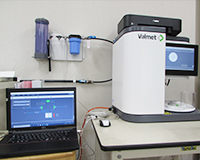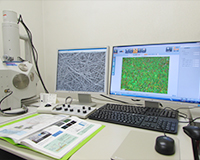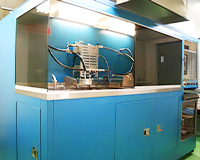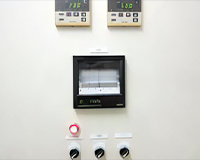Evaluation Technoloy
We use a wide variety of evaluation technologies to provide reliable products meeting the needs for end products.
Protyle Test
Protyle tests for determining the dispersibility of fiber, fiber length, and paper strength are conducted to assess suitability for papermaking.
Fiber length analysis measurement

By Measuring the length of the fiber, we confirm variability of fiber length and assess the suitability of papermaking including the strength of the paper.
Pulse NMR particle evaluation equipment

The wettability and affinity of powders and the dispersion agglomeration state of concentrated dispersion samples can be evaluated.
Disintegration degree test

In this test pulp is mainly agitated and crushed to pieces to investigate dispersibility for the determination of suitability for papermaking.
Freeness test

In this test the freeness of the raw material is measured to determine its properties, suitability for papermaking, and the effect on the physical properties.
Analysis
We respond to a variety of needs including the identification of raw material, performance evaluations, and investigations of substances of concern by conducting analyses internally or outsourcing them to analytical bodies.
Scanning electron microscope (SEM)/Energy dispersive X-ray analyser (EDX)

This microscope is used to observe the surface condition or microstructure of products and raw materials, such as fiber and powder.
EDX can also detect elements in samples with high precision.
Infrared spectrophotometer (FT-IR)

This spectrophotometer is used to identify organic compounds and some inorganic compounds. This instrument identifies foreign substances, film, coating agents, fibers, and binders.
Ultraviolet and visible spectrophotometer

This spectrophotometer is used to perform a quantitative analysis of solutions using ultraviolet light and wavelengths in the visible ranges, and to measure the transmission spectrum or the transmittance in the constant wavelength of film.
Differential scanning calorimetry(DSC)

Information on the thermal stability, melting point and glass transition temperature of organic and inorganic compounds can be obtained by heating and cooling under controlled conditions and measuring the resulting temperature and energy difference from a reference material.
Ion chromatograph (Outsourced)

This is a chromatograph for separating ionic substances, and we use it for the separation and quantitative analysis of inorganic ions in the extraction liquid of sheets.
Gas chromatograph(Outsourced)
This is a chromatograph for separating gas components, and we use it for the evaluation of gaseous adsorption sheets, and quantitative of the gas in the atmosphere.
X-ray diffraction analyzer (Outsourced)
This device is used to identify inorganic compounds (minerals) and organic compounds with a crystal structure.
GC-Mass (Outsourced)
This analytical method combines gas chromatography and mass analysis for the identification and quantitative determination of mixtures. The method is used for the identification of gases generated from paper and the evaluation of chemicals for paper, such as binder.
Characteristic Test
- Thermal Characteristic
- Chemical Characteristic
- Electric Characteristic
- Optical Characteristic
- Mechanical Characteristic
- Surface Characteristic
- Filter Characteristic
- Ventilation Characteristic
Thermal Characteristic
We investigate thermal characteristic by measuring the change in product size and strength due to thermal changes, as well as the inflammability test of materials.
Warm strength

The tensile strength in an atmosphere heated to 250°C is measured. This measurement is performed to check the processing suitability of a material like PVC when it needs to be heat-processed by a customer.
Thermal conductivity measuring device Tci Maxk

This is a non-destructive test using the hot wire method and can measure the thermal conductivity (0~500 W/m-K) of solids, powders, gels and liquids without any pre-treatment.
Thermal conductivity measuring device Xe Flash Analyser

Thermal diffusivity (0.01-1,000 ㎜2s-1)/thermal conductivity can be measured, which is an indicator of a material's heat dissipation or insulation properties.
Incombustibility test

The inflammability of a material is investigated by a method pursuant to the Building Standards Act. The inflammability is evaluated on the basis of an increase in temperature that occurs when a material is placed in a heated furnace.
Flame retardancy test (German national standard DIN)

Flame retardancy can be assessed in accordance with German national standard DIN 53 438.
Limited Oxygen Index measurement (LOI)

The concentration of oxygen required for a material to sustain combustion is measured. The grater the concentration value, the less inflammable the material.
Thermal dimension stability measurement
This measurement serves to check that there is no change in the material dimensions even when the temperature changes. In this measurement, the material is placed in an atmosphere at a certain temperature, and the dimensions are measured after a certain period of time.
Thermal gradient test
In this test, the heat-sealing properties (such as temperature and pressure conditions) of a material when hot-pressed is determined using five heat sources with a temperature gradient.
Thermography measurement
This measures the behavior and distribution of heat in a sheet to create a picture of heat distribution.
Chemical Characteristic
In this test, the influence of moisture and oil on sheets and the various properties of water resistance, water absorbability, and water repellency are investigated.
Water resistance test

In this test, the strength of a sheet when soaked in water is investigated. The tensile strength is measured after a sheet is soaked in water for a certain period of time. The water temperature may change depending on the type of sheet. Since paper is generally weak when exposed to water, it is made to withstand impregnation, coating, and use in water by employing water-resistant material, adding chemicals, or processing to provide water resistance to sheets.
Water absorption test

In this test, sheets are soaked in water for a certain period of time and then the penetration of water is measured to determine the water absorption level.
Water repellency test
Water repellency is a property related to surface wettability. There are two ways of evaluating water repellency: a method where liquid is dropped on an inclined sheet to see how the liquid drops run off and a method where the angle of the contact surface between the sheet and water (contact angle) is measured. To provide water repellency to sheets, the surface is coated with a water-repelling agent or a water-repellent material is used.
Water-resistant dimension stability test
In this test, a change in the dimension of a sheet is measured after the sheet is soaked in water for a certain period of time. Sheets expand or shrink when exposed to water and moisture. Sheets that show little change have superior water-resistant dimension stability. This physical property is necessary for materials for which the influence of water or moisture is important, such as building materials.
Wetting test
In this test, the wettability of the sheet surface is investigated by measuring the surface tension of the sheet for a liquid. Wettability is an important physical property for taking ink well for printing and retaining coating solutions and adhesives.
Oil resistant test
This is a test to determine the resistance of a sheet to oil by measuring the tensile and bursting strength of the sheet after soaking in oil for a certain period of time. Depending on the intended use of the sheet, resistance to hot oil may be investigated by increasing the oil temperature.
Oil absorption test
In this test, the oil absorption level of a sheet is investigated by measuring the weight of oil absorbed by a sheet of a certain size. This test relates to the consideration of the impregnation of a solvent-based liquid and the printability.
Electric Characteristic
Various electric characteristic are investigated according to the intended purposes in order to evaluate the characteristics of the sheet containing carbon fiber and conducting material.
Electric conductivity measurement

Electric conductivity (electric conductance) is an indicator for the amount of electrolytes in water and is used to determine the water contamination level, which plays an important role in papermaking.
Static electricity measurement

The length of time that elapses before the static electricity retained by a sheet decays by half (static electricity half-life) when static electricity of 10,000 V is applied to the sheet from outside can be measured.
Electric resistance measurement
There are two types of electric resistance: surface resistance and volume resistivity, and we measure surface resistance. We not only manufacture the base paper for the separators for lead storage batteries but also evaluate the properties of separators.
Electromagnetic-wave shielding measurement(Outsourced)
The shielding effect from electromagnetic waves that cause damage through reflection or absorption can be checked (this measurement is outsourced).
Optical Characteristic
The characteristic related to light, such as opacity, which stands for the light transmission prevention level of sheets, as well as light resistance, are tested.
Opacity measurement

The light transmission prevention level of sheets is measured. This is expressed by the ratio in reflectance between the case where a paper is placed on the specified white standard plate and the case where a paper is placed on the specified black plate. This is an important measurement for sheets when they do not need to be transmissive.
Light resistance (weather resistance) measurement
The resistance to light such as ultraviolet ray is measured. Delivering intense light from a xenon lamp that shows the wavelength distribution similar to solar light estimates the service life in a shorter time in reality. It is also possible to evaluate weather resistance by contacting water in addition to light. Depending on the circumstances, we outsource the evaluation to public institutions.
Mechanical Characteristic
In this test, mechanical characteristic such as the pressure required to burst a sheet and the durability of sheet when it is bent repeatedly are investigated.
Universal tension test

The maximum load and elongation of a rectangular test piece in a given shape (15 mm in width) when a tensional force is applied to it until it breaks are investigated. These are measured using a universal tension tester and are one of the basic physical properties of sheets.
Burst strength test

The burst strength of sheets is investigated. The pressure required to burst a sheet when vertical pressure is applied to a given area of the sheet surface with the periphery secured is measured.
Tearing strength test

The resistance generated when a sheet is torn is investigated. We measure this force using an Elmendorf tearing tester.
Folding endurance test

The durability of a sheet when bent repeatedly in the tension state is investigated. We measure this durability using an MIT-type fold tester.
Stiffness test

The flexing life of paperboard is investigated. Soft paper, such as tissue, cannot be tested. We use a Gurley-type stiffness tester for measurements.
Ring crush test

In this test, the buckling strength of a sheet is investigated. The compressive strength of the sheet used for the base paper for corrugated board and honeycomb application is measured using a ring rush tester.
Surface Characteristic
Surface characteristic are investigated by performing smoothness tests where the sheet surface and the standard plane, which is smoothly polished, are measured at a constant contact pressure, as well as a surface strength test (picking) using wax.
Smoothness test
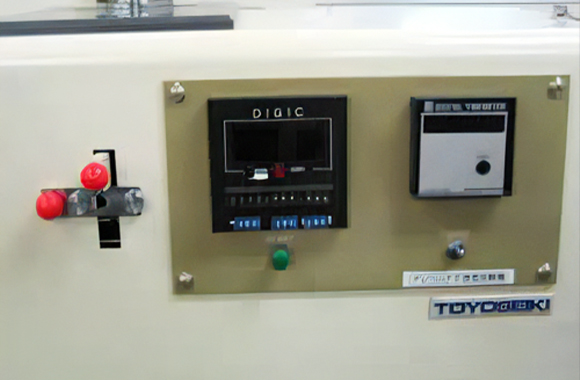
This is a test for investigating the smoothness of sheets. Smoothness is expressed in the transit time of 10 cc of air flowing through a gap when the sheet surface is brought into contact with the standard plane, which is smoothly polished, at a constant contact pressure. The longer the transit time, the higher the smoothness.
Picking (wax surface strength test)

This is a test for investigating the surface strength of sheets. In this test, the tips of 20 types of wax sticks with different adhesive force are melted and immediately bonded to the test piece surface. After cooling and hardening (left for 15 minutes), the wax sticks are taken off perpendicular to the test piece. Surface strength is expressed by the wax number on the boundary that does not cause swollenness, breakage, and paper peeling.
Filter Characteristic
Efficiency, service life, and filtration accuracy (removal rate of each particle size) of gas- and liquid-phase filters are measured.
Air filter evaluation
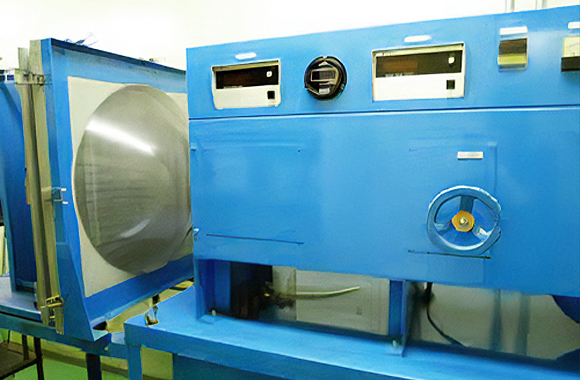
The service life and efficiency of filters are measured by creating an air element to filter a mixture of dust and air. This evaluation can also be performed using a flat sheet instead of the element.
Oil filter evaluation

The service life and efficiency of filter is measured by creating an oil element to filter a mixture of dust and oil.
Fuel filter evaluation

Filter a mixture of fuel for cars, such as light gas oil and dust to measure the cleanliness of fuel after filtration. This evaluation can also be performed using a flat plate instead of the element.
Multipass test

Using a performance check tester for liquid filter, particle removal property (efficiency) and pressure loss (life) are measured. Efficiency data is created by automatic calculation after counting the particles of each measured size (by the counting method).
Palas test
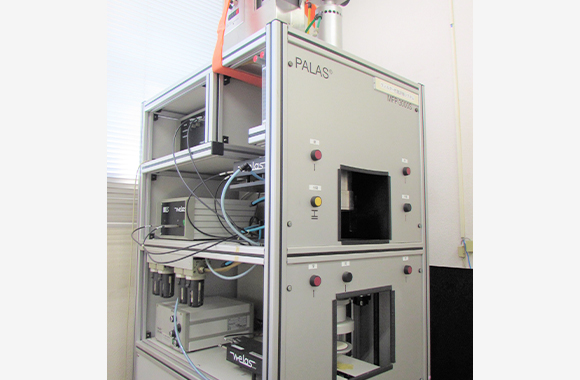
Using an air filter performance check tester, the particle removal efficiency and dust holding content(DHC) are measured. Regarding the efficiency, the particles of each measured size are counted and data is created by automatic calculation.
Ventilation Characteristic
The ventilation characteristic of sheets for allowing air and humidity to pass through are investigated.
Air permeability test
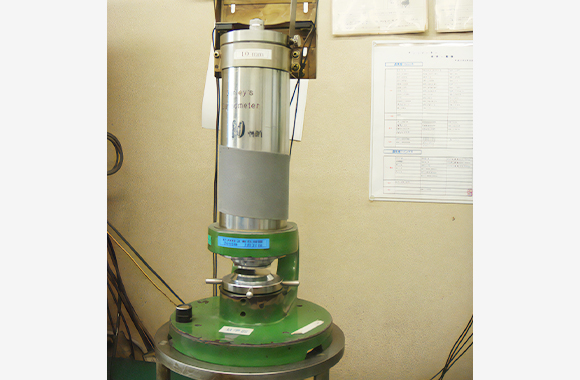
The time that elapses before 50cc,100 cc,300cc of air passes under a constant area and pressure. This test is used to evaluate the performance of different types of filters and breathing sheet materials.
Moisture permeability test
The amount of moisture permeated per day per unit area of sheet is measured. This test is used to evaluate the characteristic of the condensation prevention function and absorbent material packages related to moisture.
Environment Evaluation
The evaluation of the physical properties of sheet is affected by humidity. Therefore, measurements are performed in a constant temperature and humidity room so that evaluations can be performed under a constant atmosphere. In addition, tests need to be performed under consistent conditions, so a constant temperature and humidity bath are used.
Constant temperature and humidity room
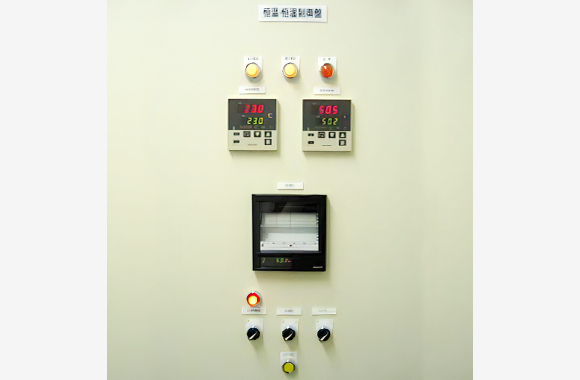
Physical properties of sheets, such as strength, may vary from changes in temperature and humidity. Therefore, they are measured in a room with a constant temperature and humidity. The environment of this room is always controlled at a temperature of 23°C and humidity of 50% as specified by JIS.
Constant temperature and humidity bath
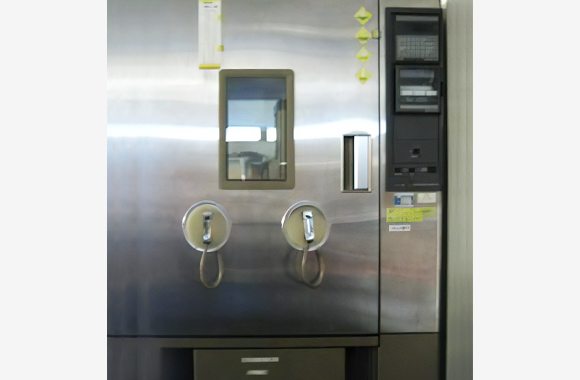
This bath is used when tests need to be performed under constant conditions. For example, the constant temperature and humidity bath is used for the measurement of tensile and peeling strength of a sheet under severe conditions, such as a temperature of 80°C and humidity of 80%.
Constant temperature bath
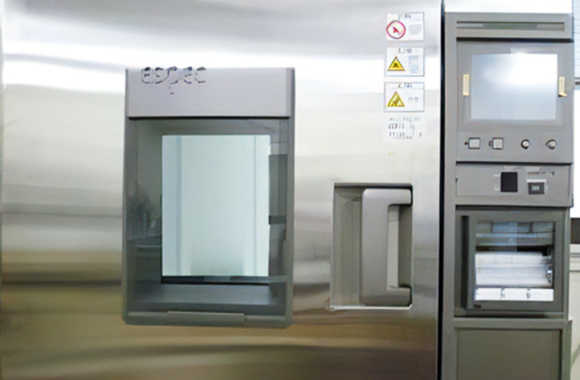
This bath is used when tests need to be performed under constant temperature conditions. This bath measures durability over time under low to high temperatures (-40°C to 100°C).
